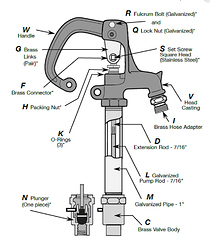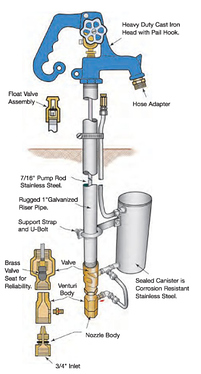I have a well guy who looked at a prospective property for me, and he is taking issue with barn living quarters area being run off of same well system as rest of barn. His concern seems to be frost free hydrants in the barn and the potential that they cause total coliform contamination–i.e. the frost free hydrants will lead to contamination of the living quarters drinking water. Sellers well guy says it’s not an issue to have barn and residential connected, and for fros free hydrants to be connected to the system . Barn well currently failed TC test (OK on e coli). Does my well guy have a point? Or have you guys been OK with frost free hydrants around the barn being connected to residential well system? Seller well guy just wants to shock the well and call it a day; my well guy says that won’t be a long term solution given frost free hydrant use. Thoughts?
Your well guy wants what? A entirely separate well for the frost free hydrants?
We’ve had no issues with the frost free hydrants being connected to the house system. No well guy has ever brought it up as an issue. There’s no bacterial contaminate in the well.
Frost free hydrants don’t drain back into the supply line, anyway?
While I have known people to have separate wells for their barn, the vast majority don’t. And I have never once heard you can’t put a frost free hydrant on a residential well. 
People install them for reasons other than farming.
Can you get a third opinion on the situation?
The water which drains back into a hydrant exits into the soil at the base of the unit. When the hydrant is turned on some ground contaminated water moves into the hydrant in the transition of the rod fro off to on. Most folks don’t realize this and in previous hydrant threads some even vehemently deny that it happens with their own hydrants.
But that possible contamination is why manufacturers make sanitary hydrants for situations when there is human consumption of water from a system with hydrants. They are used in places like parks where hydrants supply water both for human drinking and for irrigation.
My advice is to spend the money to equip your well water and barn system with all sanitary hydrants rather than standard hydrants. Sanitary hydrants are completely sealed to prevent surface and ground water from entering the service line, keeping the water in the system potable and safe for human consumption.
Here is a good write-up:
pretty darn easy, install anti backflow valves, they only allow the water to flow in one direction, we have such a valve on our barn water line that is fed from our house’s city water supply
My hydrant for the barn was run off the house supply 19yrs ago.
I had water tested around 5yrs ago & the well shocked, but coliform levels weren’t the issue, it was minerals.
I must be One Tough Old Bird as I’ve never had a problem with house water related to the hydrant.
& I drink from the barn hose on occasion.
testing
OK, that is weird, it let me post this.
I wrote a long post and it will not let me post it. I keep getting a 403 error.
Let me re-write and see if it works now that I have an actual post.
I do not disagree with the post that @LCDR posted above, though I think the second sentence should say ground contaminated water CAN move into the hydrant.
OK, that did not work, let me start with this little part. Now to edit to add more.
What typically happens to that contamination if it happens is it comes out thru the hydrant. If you see small rocks or sand at the bottom of your bucket after filling it from the hydrant, that is what happened.
It will not let me edit that anymore so let me continue here maybe.
I assume there is some sort of check valve in the well system, associated with the pump, so taking that into account there is no way for these hydrants to contaminate the well itself.
Sure, I suppose they could contaminate the piping system, but that is not a likely scenario.
If you, or your well guy, are that worried about this situation there are many solutions that do not require a new well. Both have been mentioned. In line backflow prevention or the sanitary hydrants.
I have no protection between my non-freeze yard hydrants and my house. I am 100% not worried about it. I will add that this type of stuff is associated with my job.
I appreciate all the info. The sellers have a few weird things going on with their water. They said there were 2 wells servicing the barn, one for stabling area, one for residential area. It turns out both wells were feeding the same lines throughout the facility such that water is intermingled from both wells. Only one of the wells is permitted for residential use. The one that s permitted for residential use is only producing a gallon a minute and needs to be decommissioned per my well guy. The one that is actually productive and supplying the whole facility is more than 500 feet from the barn, and is only permitted for agricultural use currently, although current owners have been using it for the entire facility, residential included. My well guy says it may be that we could get a residential permit for the ag well, but he is skeptical that there would be a long term fix to the TC issue without the hydrant issue being addressed. I will ask him about sanitary hydrants. Seller claims none of this is a big deal and does not want to make any meaningful price concession on an expensive property.
Can you get another opinion?
Your well guy insisting the hydrants are the big problem here makes me scratch my head.
No, I am not saying this well not tested for potable water usage should just be ignored, but I do not agree with his theory that the hydrants are the big issue here.
If the water lines to the hydrants are exposed anywhere, adding some sort of check valve there is much easier than replacing the hydrants.
Adding to the sanitary (anti-backflow) hydrant installation/renovation.
My house, in the city, on city water has 2 frost free hydrants. One inside my mudroom on an outside wall and my outdoor spigot. The only issue there has ever been is with the city plumbers busting my outdoor spigot* to get me water by back feeding from the neighbour’s water line one winter when my water line froze out at the road. The city replaced it in the spring with another frost-free one.
Get another opinion on this plumbing issue/non issue.
Get another opinion on what it would take to get the producing well up to standards for potable water.
*you can’t back feed through a sanitary frost-free hydrant without breaking it or bypassing it
The type of non-freeze hose bibb that you have coming out the wall of your house works differently than a non-freeze yard hydrant.
The hose bibb simply has the shut off portion of the unit a distance from the handle so it is inside the conditioned building. It is installed on a slight angle so the remaining water drips outside after the valve is shut off.
He probably wants you to spend more money.
Info;
My county health department is telling me that the presence of the frost free hydrants would impact their ability to convert the ag well to residential well certification, unless there are already backflow devices installed on the hydrants. Does anyone know if backflow prevention devices can be installed after the fact? I am going to try to find out from the seller if the existing hydrants already have them
Yes!
A simple check valve is a backflow device.
They are easily installed.
You will just need them on the lines feeding the hydrants.
Confirm with your health department what they want for a backflow prevention device. I assume they are not asking for something like an RPZ or a double check.
Edit to fix bad typing. Are and area are not the same word.
A frost free hydrant has a backflow device built in. When you press the handle down the water valve is closed and any water above the valve is drained out.
Sanitary hydrant;
Because the hydrant drains into a sealed canister and not into the ground through a “drain outlet”, the water never comes in contact with the soil. This conserves water and avoids possible contamination of your water supply.


